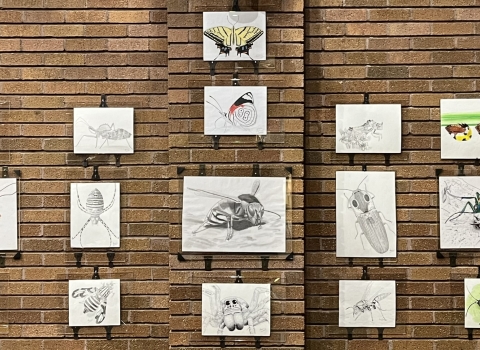There is currently a Harmful Algae Bloom at Lake Lowell, with high concentrations of toxin-producing cyanobacteria that can be harmful to people, pets, and livestock. For more information, see the Public Health Alert.
(Español) Hay una floración de algas nocivas en Lake Lowell, con altas concentraciones de cianobacterias productoras de toxinas que pueden ser perjudiciales para las personas, las mascotas y el ganado. Para más información revisa el Aviso de Salud.
Visit Us
National wildlife refuges offer us all a chance to unplug from the stresses of daily life and reconnect with our natural surroundings. With a nearly 9,000-acre lake and more than 10 miles of trails, refuge visitors can easily find an adventure for their experience level. As you visit this wildlife home, be sure to slow down to watch wildlife and look for signs of wildlife like tracks, scat, and nests. Whether you come to fish, boat or swim in Lake Lowell or to hike, bird, hunt, picnic or just watch a sunset in the nearby uplands, there are many opportunities to connect with nature during your visit.
Location and Contact Information
About Us
Deer Flat National Wildlife Refuge is an urban oasis where nature connects people, communities and wildlife. We welcome diverse communities to develop meaningful connections with nature and each other through educational and recreational experiences. The Lake Lowell Unit protects nesting colonies of western and Clark’s grebes and spectacular migratory and wintering concentrations of mallards and Canada geese. The Snake River Islands Unit provides important nesting habitat for ducks, geese, songbirds, herons, egrets and more.
What We Do
The staff and partners at Deer Flat National Wildlife Refuge work year-round to maintain and enhance refuge lands and programs for both wildlife and the community. Our conservation toolbox includes controlling invasive species invasive species
An invasive species is any plant or animal that has spread or been introduced into a new area where they are, or could, cause harm to the environment, economy, or human, animal, or plant health. Their unwelcome presence can destroy ecosystems and cost millions of dollars.
Learn more about invasive species , restoring degraded habitat, creating new habitat, providing artificial nesting habitat, and seasonally or permanently closing some lands to provide undisturbed areas for wildlife.
Our Organization
Our Species
The lake, wetlands, riparian riparian
Definition of riparian habitat or riparian areas.
Learn more about riparian forests, and sagebrush sagebrush
The western United States’ sagebrush country encompasses over 175 million acres of public and private lands. The sagebrush landscape provides many benefits to our rural economies and communities, and it serves as crucial habitat for a diversity of wildlife, including the iconic greater sage-grouse and over 350 other species.
Learn more about sagebrush uplands protected by the refuge provide homes to resident and migratory wildlife and native plants. Just a short drive from the busy Treasure Valley, you can spot bald eagles and other raptors, spectacular concentrations of migrating and wintering waterfowl and western and Clark’s grebes at one of the three largest nesting colonies in Idaho.
Get Involved
Whether you want to further conservation, learn more about nature or share your love of the outdoors, you’ve come to the right place. National wildlife refuges provide many opportunities for you to help your community by doing what you love. National wildlife refuges partner with volunteers, youth groups, landowners, neighbors and residents of urban and coastal communities to make a lasting difference. Find out how you can help make American lands healthier and communities stronger while doing something personally satisfying.







